Out of Harms Way
 Wednesday, June 2, 2010 at 11:25PM
Wednesday, June 2, 2010 at 11:25PM The Killdeer nesting in the field were going about their business as usual: regulating the temperature of their eggs, eating insects, warning off curious onlookers, and feigning a broken wing to divert dogs and their humans from the nest locations. As I said in my last post In Harms Way, they had no idea what was about to transpire.
The only solution to save the birds would be to try and catch the birds on their nest and then collect their eggs and nesting material just before the Marines landed their helicopter gunships and troop carriers on the field.
So the day arrived, Sunday May 30th, my wife Melanie and I got into the car and drove down to the sanctuary. Being a hot and beautiful summer-like day, the traffic jam leading up to the amusement park entrance (that also happens to be the entrance to the sanctuary access road) was at least a mile long. The county police sergeant who I had been speaking with in preparation of the Killdeer rescue plan was extremely helpful and actually provided a police escort to get us through traffic and crowds to reach the sanctuary an hour before the scheduled landing.
It was a hectic scene that greeted us upon arrival. Fire trucks moving into position the road near the landing zone and nesting area. Amusement park staff were in process of pulling up the protective barriers around the nests (they were not supposed to), and everyone was asking questions and talking at once. The administrators in charge of the event were helpful though, and everyone seemed to be interested in what we were attempting on behalf of the birds. They seemed genuinely concerned about saving the Killdeer and their eggs. I found this refreshing and encouraging.
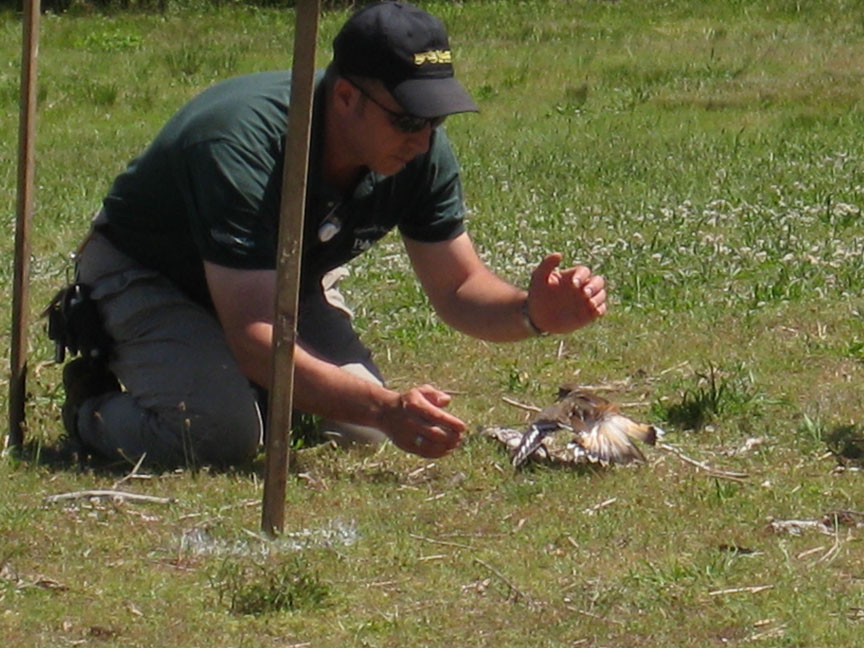 Birds don’t like their nests disturbed, let alone removed altogether, then replaced, so I had no idea if my plan would be successful. I hoped that the two hour "disappearance" of the eggs and nest would not cause the Killdeer to abandon the area.
Birds don’t like their nests disturbed, let alone removed altogether, then replaced, so I had no idea if my plan would be successful. I hoped that the two hour "disappearance" of the eggs and nest would not cause the Killdeer to abandon the area.
Zero hour was moved up so that we had only about 30 minutes before the helicopters arrived. Two of the sanctuary’s volunteers were on hand to help with the rescue. I walked slowly up to the first nest with the Killdeer sitting on her eggs. I began speaking to her again in reassuring tones as I inched closer. She of course gave her warning cry repeatedly. I sat right next to her and the nest – half an arms length away looking for the right moment to grab her as gently as possible. She protested loudly, and flew at my bare hands as I moved closer. Repeatedly she struck at my hands with her sharp beak, and I realized that she would not be so easy to capture despite my hands being inches from her. I did not want to cause her harm or more stress than was necessary. (I could have tried using a net but felt it would be too stressful.) As she attempted to lure me away with the broken wing act, I marked the eggs with a small dot using a magic marker so that I would be able to keep the eggs in the upright position when returning them later. I collected the bits of tattered cardboard and small bits of sticks that made up the nest.
With the nest and eggs gone, the killdeer was very upset, flying in circles around the area. I felt bad having to cause her such distress, but it was the only hope of saving her chicks-to-be.
We repeated this process for the other nests that had eggs in them, and brought them back to the sanctuary, positioning their rescue boxes open in full sunlight. The eggs were hot to the touch, which was as it should be – around 90 degrees F. It so happened that the air temp that afternoon was exactly 90 degrees. If we had cooler or wet weather to deal with, it would have been more complicated to maintain proper incubation temperature.
So with the eggs safely stowed outside the nature center building, the volunteers and my wife and I headed back down the road to watch the landing. Within a few minutes the first helicopters began arriving, circling the field several times before landing, one at a time. Then the MV-22 Osprey came in and landed. The combined effect these aircraft had on the nesting field was to blast nearly every fleck and particle of debris from the area. (See video clip). The Osprey craft alone with its tilt rotors and vertical thrust burned the ground and sent clouds of dust high into the air. No Killdeer nest would survive that.
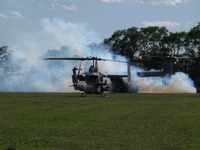 MV-22 Osprey on nesting field. (Click for larger image)
MV-22 Osprey on nesting field. (Click for larger image)
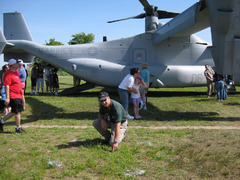 A Killdeer nest site - nest and eggs removed. (Click for larger image)Next, the Marines exited the crafts and deployed nearby for the crowd to see. Once the rotors were shut down and helicopters secured, the crowd ran onto the field to inspect the admittedly cool looking aircraft and shake hands with the clean cut Marine pilots and troops. None of them had any idea that there was this life or death drama taking place in the same field.
A Killdeer nest site - nest and eggs removed. (Click for larger image)Next, the Marines exited the crafts and deployed nearby for the crowd to see. Once the rotors were shut down and helicopters secured, the crowd ran onto the field to inspect the admittedly cool looking aircraft and shake hands with the clean cut Marine pilots and troops. None of them had any idea that there was this life or death drama taking place in the same field.
My wife and I inspected the marked locations of the nests as shown in the accompanying photos. We had done the right thing and were relieved. Last summer, before I was stationed at the wildlife sanctuary, the same Marine mock raid took place and the parks staff at the time thought that placing stacks of sandbags around the nest and eggs would work. It did not. The vortex/blast of the rotors still obliterated the nest and eggs. Getting the eggs out of harms way was the only solution.
With the Marines done for the day, the take-off was equally destructive to whatever might have been in the vicinity with large plumes of exhaust smoke belching from the Osprey. (See photos and video clip). The Canada Geese on the opposite end of the field began to exit en masse as the whine of the engines increased.
With the military show over successfully and safely, we quickly set about reconstructing the nests and replacing the eggs just as we had found them, being sure to put the right eggs in the right nests, right side up. Protective barriers back in place, I looked about for the Killdeer but did not hear or see any. Nothing more for us to do, so we all packed up and headed home.
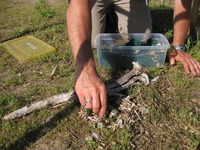 Returning eggs and nesting material. (Click for larger image). Photos by Melanie GambinoHalf an hour later, I got a call from the wildlife rehabilitator who had stopped by to see if the birds had returned to nest. Indeed they had! My wife and I were happy and relieved – and exhausted from the excitement and tension of the day.
Returning eggs and nesting material. (Click for larger image). Photos by Melanie GambinoHalf an hour later, I got a call from the wildlife rehabilitator who had stopped by to see if the birds had returned to nest. Indeed they had! My wife and I were happy and relieved – and exhausted from the excitement and tension of the day.
What we hope for is still about 14-18 days away – Killdeer chicks hatching. With luck, the chicks will hatch as if nothing happened. That will be the final and most important marker of success.
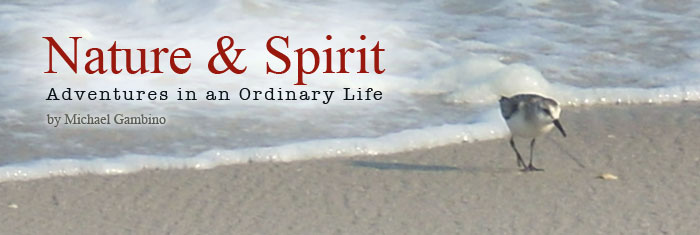
Reader Comments (9)
Whew! What a relief! I wouldn't have thought that the birds would have returned to the nests after the eggs being "missing" for so long. It sounds like a happy ending, afterall. Looking forward to seeing some cute chick photos and videos.
How very exciting and wonderful that you & Melanie and others saved the birds and their nests. I do not have these birds where I live, but my son and daughter-in-law have them on
their property.
Good job, well done. Joan
Wow, Mike, thanks for sharing that with me. I'm inspired by your commitment to see this through!
BTW - the geese marching reminded me of military soldiers doing their maneuvers too.
Glad you saved them, but moreover, you educated people who read your blog.
-DG
Michael, such heroics for the sake of the meek, merit a medal. yyou need to take your story and "go tell it to the Marines!" Thanks for posting this.
You and Melanie are indeed natures little angels, thank you for educating us and for being there for those adorable creatures. Please also extend appreciation to those who helped you achieve a thoughtful goal. I'm enjoying your site.
Awesome, Michael! I read that story like a suspense novel!
Michael, this post was a thriller -- a real race against time. I'm so glad the birds returned to their nests. Hopefully the rest of the story will go smoothly and have a very happy ending. Thanks to you and your wife for looking out for these beautiful birds.
Thanks to all of you who are taking time to post comments on this site or to e-mail them to me. It is encouraging and truly appreciated!